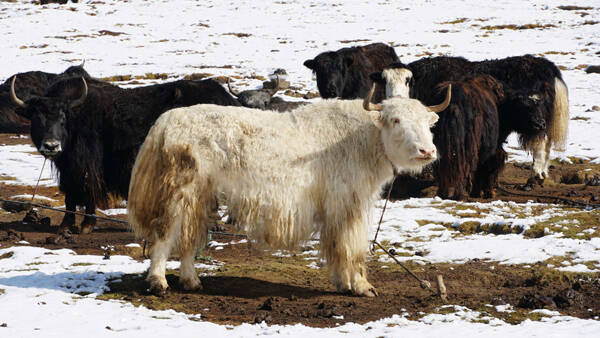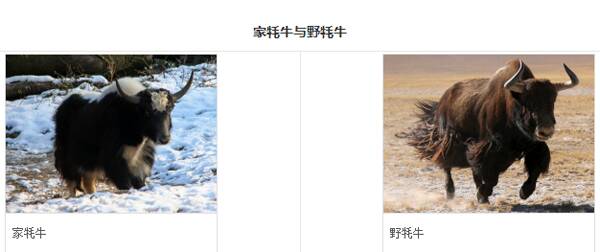Bos grunniens
IUCN
LCBasic Information
Scientific classification
- name:Bos grunniens
- Scientific Name:Bos grunniens
- Outline:Ungulata
- Family:Artiodactyla Bovidae Bos
Vital signs
- length:About 2 meters
- Weight:260-440kg
- lifetime:About 25 years
Feature
It is the most famous livestock in the high altitude areas of central Asia.
Distribution and Habitat
Domestic yaks are a unique domestic animal domesticated in areas above 3,000 meters above sea level. They are a precious cattle breed on the roof of the world. They are concentrated between 70°-115° east longitude and 27°-55° north latitude. Outside China, domestic yaks are distributed in high mountainous areas close to the yak production areas of the Qinghai-Tibet Plateau in Mongolia, Russia, Afghanistan, Pakistan, India, Bhutan, etc., accounting for about 7% of the total number of yaks in the world.
China is mainly distributed in the Qinghai-Tibet Plateau, followed by Gansu, Sichuan, some mountainous areas of Yunnan and Xinjiang bordering Qinghai and Tibet. They are also distributed in Mongolia, the former Soviet Union, Afghanistan, Nepal, India and other countries adjacent to China.
Domestic yaks live in high altitude areas of 3,000-6,000 meters, live in a specific high-altitude high-cold climate zone, and are high-cold resistant cattle breeds that follow the snow line and cha
Appearance
The average body height of adult male and female domestic yaks is 129 cm and 111 cm respectively; the weight of adult male and female yaks is 440 kg and 260 kg respectively. The head is heavier, the forehead is short and wide, slightly domed, the neck is short, thick and deep, the nose is long and slightly sunken, the nose is turned down, the eyes are prominent and bright, and the ears are small. Both male and female yaks have horns, which are large, thick and long, about 90 centimeters. Generally, the tip of the horn opens upward, forward or backward in an arc shape, and a few have no horn. The temples are high, wide and long; the temples are tall and gradually tilted backwards, the back is low and flat, and the cross part is raised. The chest is short, deep and broad. The back is short, the ribs are open, the abdomen is large and the waist is long, the forelimbs are short and straight, and the hind limbs are knife-shaped. The buttocks are sloping into a ridge shape. The short tail ha
Details
Domestic Yak (scientific name: Bos grunniens) is an artificially cultivated animal of the order Artiodactyla, family Bovidae, and genus Bos. It is called "Zhong" in Tibetan and is the most typical animal on the Tibetan Plateau. It is large in size and has strong vitality.

The length and fineness of the domestic yak's coat vary and change with the seasons. The side and lower skirt hair is dense and long, which can keep out the cold and damp, and is suitable for cold climates. The yak has a large chest, a well-developed heart, a short and thick trachea, large red blood cells, a high hemoglobin content, fast breathing and pulse, and is adapted to the hypoxic environment of the plateau. The mouth is wide and the lips are flexible, which can chew short grass; the hoof is solid and padded, the temperament is gentle, the reaction is sensitive, the established conditioned reflex is relatively solid, and it is easy to train; it has strong disease resistance, strong resistance to adversity, strong sociability, wide diet, tolerance to hunger and thirst, and tolerance to extensive feeding and management conditions. Due to the special structure of its coat, skin and hoof, and the abnormal structure of its mouth, nose, lips and tongue, it can climb high mountains and steep ridges, places where sheep cannot pass and pastures that cannot be used, they can pass smoothly and feed, so it is known as the "Boat of the Plateau". Yaks can also roll, which is a habit that other cattle species do not have. Yaks have good working performance. In alpine grassland areas, they can carry 50-100 kg and travel 20-30 kilometers a day. In addition, they can be used for riding, plowing, pulling carts, etc., and the service life can reach 15 years.

Male yaks can participate in breeding after they reach sexual maturity at the age of 2. The breeding ability is strongest between the ages of 2 and 6, and then gradually weakens. During natural mating, the ratio of male to female is 1:20-30, and the age of use is about 10 years old. Female yaks generally begin to estrus and breed at the age of 2-3.5 years old. More than 60% of them give birth once a year, and about 30% of them give birth once every two years. The twin calf rate is 1%-2%. Female yaks are in estrus seasonally, usually starting in mid- to late June, with the peak period from July to August. They give birth from April to July every year. The estrus cycle is about 21 days, with large differences between individuals. The estrus lasts 41-51 hours, and the gestation period is 250-260 days.

Wild yaks and domestic yaks belong to the same species, the former are wild animals and the latter are domesticated animals. The main differences between them are different living environments, different appearances, and different temperaments. Wild yaks are larger than domestic yaks, and adult males generally weigh 400-800 kilograms, and the largest can exceed 1 ton. With a body length of 2-2.6 meters and a shoulder height of 1.6-1.8 meters, it is the largest wild animal in central Asia. Wild yaks grow in the wild, while domestic yaks grow in captivity. They have different temperaments: wild yaks are fierce and warlike, while domestic yaks are more docile. They are different in appearance: wild yaks are large, while domestic yaks are small. Wild yaks have coarse hair, while domestic yaks have fine hair. Wild yaks have prominent shoulders, while domestic yaks have flat shoulders. Wild yaks have long chest hair, while domestic yaks have short chest hair. Wild yaks have purple-black hair, while domestic yaks have red-black hair. Wild yaks call like pigs, while domestic yaks call like cows. Wild yaks are particularly alert when looking at people, ready to run away at any time, while domestic yaks are not like this. Wild yaks have sharper horns and are more agile than domestic yaks. Wild yaks are first-class protected animals in China, while domestic yaks are not.

According to measurements, the net meat rate of adult castrated yaks is 42.5%. The average daily milk production of multiparous yaks is 1.38-1.70 kg. The lactation period is generally about 150 days, with an annual milk production of 274 kg and a milk fat rate of 6.37-7.2%. The wool is harvested once a year. The annual wool production of adult yaks is 1.17-2.62 kg; that of young yaks is 1.30-1.35 kg, of which half is coarse wool (skirt wool) and half is downy wool. The diameter of coarse wool is 64.8-72.9 microns, the diameter of two-type wool is 34.8-39 microns, and the diameter of downy wool is 16.8-20.3 microns; the length of coarse wool is 18.3-34 cm, and the length of downy wool is 4.7-5.5 cm. Domestic yaks are mainly used for labor, mainly for carrying, but also for riding and pulling. Generally, they carry 50-100 kg of goods, travel 20-35 kilometers a day, and can walk continuously for more than 15 days; the maximum load is 304.0±75.9 kg, which is equivalent to 78.8% of the average body weight. A single vehicle can travel 30-40 kilometers a day.
At the end of 2016, the total number of domestic yaks in China was about 14 million, accounting for 1/6 of the total number of cattle in China, ranking third after cattle and buffaloes. Among them, there were about 4.97 million in Qinghai, about 3.93 million in Tibet, about 3.88 million in Sichuan, nearly 1.06 million in Gansu, about 230,000 in Xinjiang, and about 60,000 in Yunnan.
Protect wild animals and eliminate game.
Maintaining ecological balance is everyone's responsibility!








